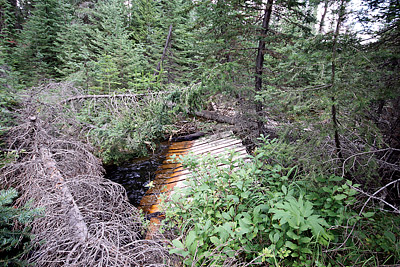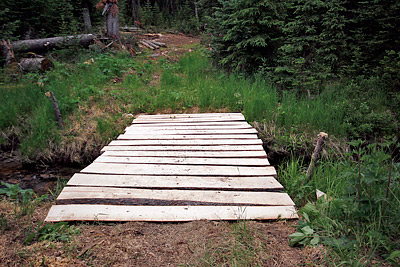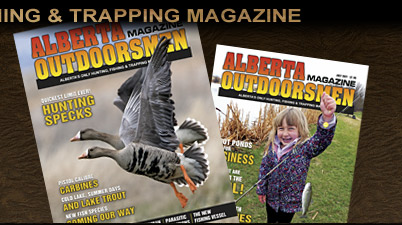|
 |
The problem in the mountain’s is that bridges don’t seem to last unless they’re built up higher than spring runoff and all the debris that comes downstream with it. I’ve lost some nice ones over the years,” said AO trapping writer Brian Bildson after viewing a thread on the Alberta Outdoorsmen Forum where I had posted photos of a bridge and its construction.
“That particular creek is a tributary to the main one on my line, plus it’s near the headwaters so I should be okay.
“Having said that, I know the problems you’ve had, so I’m keeping my fingers crossed,” was my response.
My trapline is situated in the foothills of the Rockies. It consists of forty-eight square miles of coniferous forest and at least twenty creeks that I know of. It’s not a huge line by trapline standards but it’s not a small one either. I’ve yet to explore the entire trapline—the southern parts are still unknown—so my creek count is definitely on the low side.
 |
| The incredible power of water. The bridge now lying 30-feet downstream from its original position. |
My cabin sits along a creek at 3400 feet but the majority of my line runs at better than 4000 feet with some of it pushing 4300 feet, a difference of 900 feet from the surrounding hills down to my cabin. Looking at a 3D view in Google Earth, my cabin sits in the bottom of a long valley with numerous creeks feeding the main creek and its tributaries at the bottom.
Because of the many creeks, travel on my trapline would be extremely limited without the use of bridges, at least until the weather turns cold. Even then, many springs keep parts of the creeks free running year round, so one would still have to choose his way.
Like every trapper, I have a mapped route that runs through what I expect to be the most productive furbearing areas. My particular route is 38 miles long from start to finish, travelling through everything from muskeg and bogs to high ridges and creeks.
Along this route, I have better than 50 marten sets and when the snow flies and tracks give away their secrets, I’ll have near the same number of lynx cubbies, including numerous mink, weasel and squirrel sets. Not to mention snares for the canids.
Access to one particular old growth forest on my line requires the travel over five creeks, two that are fairly substantial. One of these is where I built the bridge pictured above, with the help of my friend Pierre.
 |
| The Alaskan Sawmill built bridge just six weeks prior to the flash floods that wreaked havoc on the author’s trapline. |
The bridge took about six hours to construct in total. With my Alaskan Sawmill, I cut the planks from large timber fallen by seismic crews who had used them for their own bridges—logs merely lined side-by-side across the creek and staked at each corner. They had removed them, as they are required to do, in the spring.
When I left my trapline that weekend, I was quite proud of the bridge. I had even travelled across it on my quad exclaiming, “A tank could cross this thing!”
With the Trapper’s Convention and holidays coming up, it would be six weeks until I could return. During that time, I kept an eye on the Environment Canada website, wondering if it would ever stop raining in the region of my trapline. Calls for 40- to 60-millimetres of rain were common and thunderstorm warnings were issued with regularity. “This can’t be good,” I thought.
Six weeks later, my son Dakota and I returned to continue prepping for the trapping season. They say “a trapper’s work is never done” and there couldn’t be a truer statement. Little did we know, that weekend our workload was going to double.
From where I park my truck, it is a 1.6 kilometre trip by quad to my cabin with three bridge crossings, small ones albeit, but bridges nonetheless. I knew there was going to be problems when we arrived at the first bridge, only to find it was no longer there. The same held true for the next two but the flash flood that had taken them out had also altered the terrain and we were now able to get around them. Only one had to be put back in before we could reach my cabin.
The Alaskan Sawmill bridge, well, you can see in the photos what happened to it. It has been salvaged and is now in pieces, some of which have already been used in other places.
As they say, back to the drawing board. ■
For previous Outdoor Pursuits click here.
|
|
|
|


